It’s hard to remember, but NBA Live was once a challenger to the formidable NBA 2K. If you care about aggregated ratings, NBA Live 10 and NBA 2K10 finished in a dead heat. Live had stolen away one of 2K’s top designers. It was fargin’ war. Then EA Sports burned down everything. We haven’t seen the series since 2009.
That part of the story is more well known, beginning in EA’s Canada studio with Andrew Bynum’s crucifixion and moving to its Florida installation, which likewise whiffed on publishing a game, sacked the creative leadership behind it, and started all over for a third time this year. The destruction of NBA Live 10, which EA Sports allegedly spent a year tearing down and salvaging, must go down in history as one of the most foolish decisions and reinforced failures that video games development has ever seen.
EA Sports never meant for NBA Live 14 to challenge a goliath like NBA 2K14. This game is supposed to be a foundational effort, something that re-establishes the series as playable and credible. What I’ve seen shows even that is too lofty a goal on a one-year schedule.
There is a game in here, and it is playable and it does behave distinctly from other basketball games. But that game typically surfaces in a controlled, experimental environment, after guidance from someone who built it. In free play, the trial-and-error demands of understanding it are a huge barrier to fun. Even when you do understand what it expects, there’s a lot of forethought and choreography needed to showcase a sport that delights when it is played more instinctively and free-flowing.
The game itself provides almost no instruction, much less any kind of a tutorial or practice mode, to newcomers. After an absence of four years, we’re all newcomers to NBA Live. My advice is to pick a team whose players you know, pair them against a worse team, select 12-minute quarters and then turn off all rules so you can experiment. The fact you need to create this kind of laboratory in the absence of a practice is ridiculous.
The basic controls of NBA Live 14 are the bread-and-butter of hoops games; square (or X) shoots, X (or A) passes, R2/trigger is your turbo (which turns a layup into a dunk), fiddling with the right thumbstick gives you the razzle-dazzle. It’s when these moves are ineffective that the game does nothing to tell you why you used them incorrectly, or if you should have been using them in the first place.
Shooting — essential as it is to scoring and thus winning — is the best example of NBA Live‘s maddeningly inscrutable gameplay. A player has a red circle underneath him when he has the ball. In the act of shooting, when it flashes white — I think, the game never, in any part of gameplay or its online instruction manual, tells you for sure — that’s when you release the square button for proper timing on the shot.
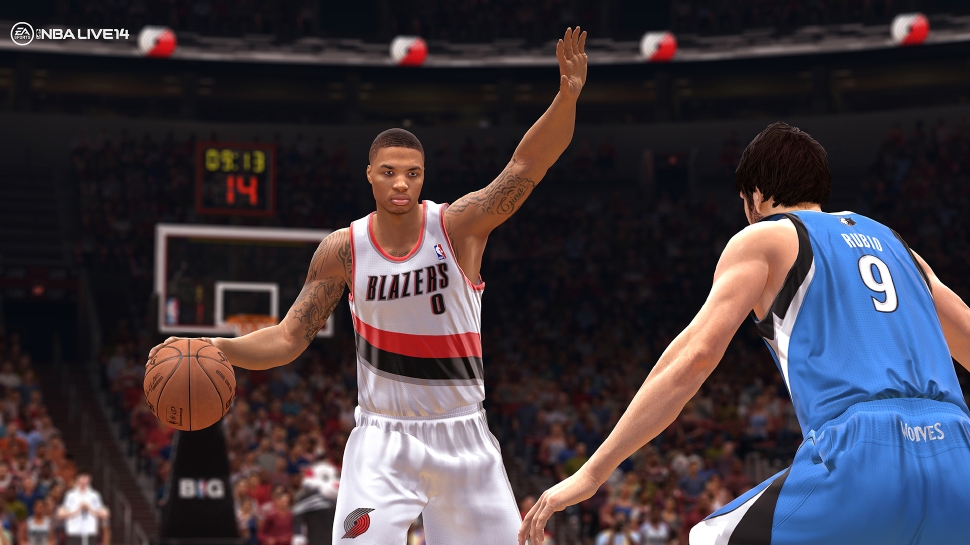
Sometimes the ball goes in when it flashes, sometimes it does not. Sometimes the ball goes in when it doesn’t flash. This probably is because of the basic skill-plus-ratings method of gameplay, which is necessary because if you figured out every player’s timing on your team, you would never miss a shot. So it’ll depend from where on the court you shoot, and whether you do so while defended.
But in the barebones scrimmage setup I described above, I tried five times to find out where the meter would flash with Stephen Curry of the Golden State Warriors. It stayed red the longer I held it. In fact, his release point is so early I missed it until my sixth try. Until I figured this out, one of the league’s most prolific scorers was unavailable to me. But then, as the clock ran out on the quarter, I dished it to Klay Thompson, one of the league’s best spot-up shooters. Thompson buried it for three at the buzzer; his shooting indicator never flashed, either.
It’s important to note that in the standard broadcast camera mode these player indicators are completely obscured, either by the crowd or the scoreboard chyron, when they’re at the bottom of the screen. In all other views it can still be obscured by other players or be hard to pick up against the floor art or reflections off the court. (In Rising Star, NBA Live‘s solo-player career mode, do not ever use the default player-lock camera. The ridiculous swing it takes when your the pass goes into the corner makes catch-and-release shooting from there impossible. Use the baseline high camera angle in all modes of play.)
The unreliable player indicator is a horrible way to handle shooting. NBA Live 14 would be much better off — and I don’t believe 2K Sports has a software patent on this idea — just flashing you a message in the upper corner whether your timing was early, late, or perfect. You’ll have plenty of time to read it in transition, as offensive rebounding by your CPU-controlled players seems nonexistent. Anderson Varejao has an offensive rebound rating of 94 out of 100. The way he stands there with his forearm on his man’s back as the ball comes off the rim, you’d think it was 94 out of 1,000. There is, frankly, a lot of staring at rebounds, behaviour that calls to mind AI glitches that were on display during NBA Live 13‘s disastrous E3 2013 presentation.
That’s shooting. Ballhandling moves progress through three levels of control but again, without experimentation, the game doesn’t explain how to use basic directional movement and timing to make them really effective. Crossover dribbles, in-and-out moves and hesitations are easy enough; if you lay on the L1/bumper modifier, the player will perform a “signature” move of the same type, but whose special efficacy isn’t that apparent to me. Both moves need to be combined with a standard movement to both throw off your defender and carry you where you want to go. Except for the spin, which is both movement and space-creation (wind a half-circle clockwise or counterclockwise on the right stick.) It’s very overpowered, and as a bail-out manoeuvre in the low post it leads to a lot of dunks.
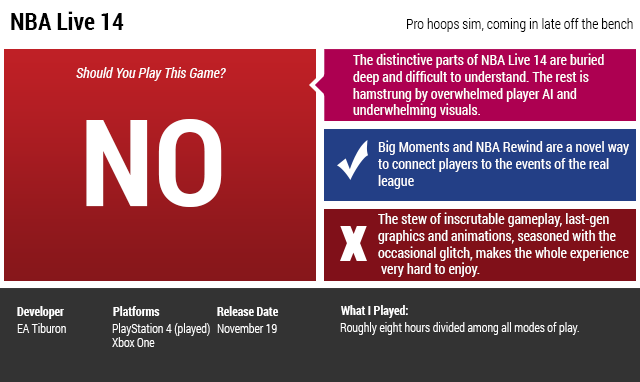
Defensive AI falls for ballhandling tricks too easily, or doesn’t recover from them fast enough, making the whole game seem set up toward spamming that control. Fooling around with the Miami Heat, Norris Cole went unmolested to the basket against his man on three straight hesitation moves from the circle. (Cole was in the game, something I had run from NBA Rewind, because Mario Chalmers had been suspended that day. But instead of swapping Cole into the starting lineup at point guard, NBA Live 14 substituted him with a generic ringer — a white guy by the name of “Point Guard,” until I brought in Cole.)
Defence compensates for this by ramping up the blocks, neutralising mid-range or pull-up jumpers. The game is plainly set up to get you to perform a juke or some kind of freestyle move before shooting. Just ticking that box improves your odds of success more than proper spacing or hitting an open man.
Playcalling, the utility that most would rely on for getting the ball to the basket without fancy streetball work, is like reading the instruction manual on a car as you are driving it. The D-pad controls what plays you call: down for a cut, left for isolation, up for a screen, right for post-up. Using the L1/bumper modifier, you can call one of four designed plays of each type. That’s great, but I have no idea who the ball is going to. What is 40 Reverse Post? What is Pin 2 Clear? Horns Strong Down? I can’t decipher the jargon of Madden NFL‘s playbook, either, but at least it has a practice mode and a visible map of who gets the ball when I call the play.
A third option is to call for a quick, improvised cut, isolation, screen or post dedicated to a specific player, by double tapping the D-pad command and then the intended player’s corresponding face button. But then I lose the help of the floor diagram (whose low-contrast colours against the hardwood also arrive late, obscured, or sometimes just don’t show up). I’m still not sure what the effective difference is between a designed screen, a screen called for a specific player, or just throwing him the ball and calling the screen yourself with L2/trigger. (Which is one of the few things NBA Live 14 does simply and understandably. Hold L2/trigger and a screener will come out to you; use him to scrape off your defender, then release L2 and he’ll roll back to the basket.)
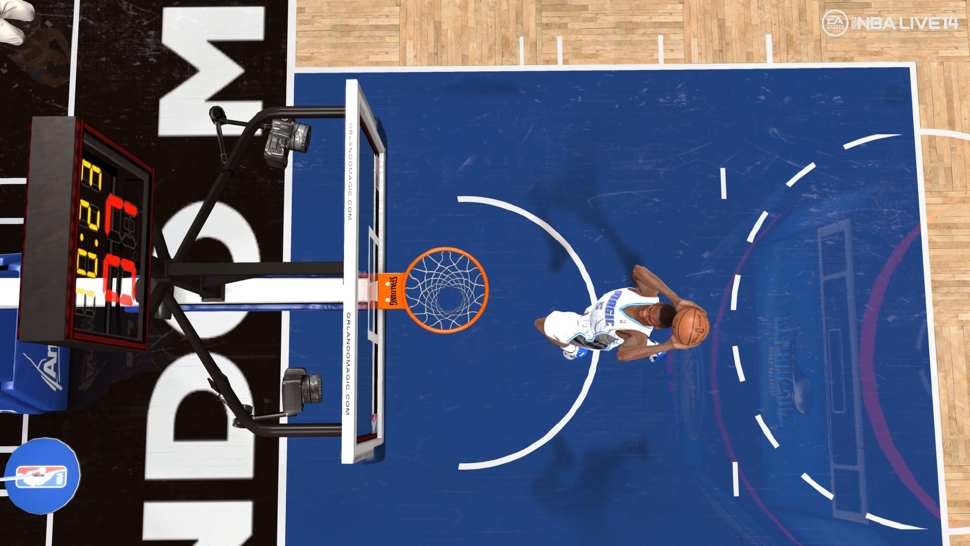
Playcalling is most poorly implemented in modes where you control a single player — whether that’s the Rising Star career mode, or in what is otherwise a strong idea, the Big Moments challenges that ask you to recreate actual events of the league. (There’s a team version of this called NBA Rewind). This game does not run an offence by itself in those modes. It’s up to you to call plays, whether you’re the point guard or a centre. This is a frustrating demand for those who want to play as a big man and work the post game (which is another phase of control altogether) or cruise the perimeter, get open and bury the three. Only in transition will your teammates work independently to try to score. In a half-court offence, your point guard — assuming he isn’t you — brings the ball up and stands there, waiting for you to call the play for him.
I’m sorry, one reason I always pick shooting guard in these career modes is because I just don’t have time for that shit. I openly admit I don’t know how to run an offence for four other people. I can run it for one, as I did in my debut with the Celtics, when I scored 29 points on 34 per cent shooting and lost to the Raptors. Like Antoine Walker, I called nothing but threes for myself — because they are no fours. The hamhanded approach to play-calling in a single-player mode is infuriating. It shirks the duty of developing an offensive AI for that mode and offloads it to the user in a way that makes no sense.
A final note about the teeth-grinding frustration of the solo modes: your pass commands are preloaded and apparently have an infinite window for doing so. If someone inbounds the ball to a bot player and you hit X from the far end of the court, whether by instinct, impatience or whatever, the guard will turn and fire it to you as soon as he touches the ball. As much as we despise the “Bad Call for Pass” in NBA 2K‘s MyCareer, at least the game doesn’t act on the bad call for a pass. This pre-loading occurs in team modes, too, so if you’re frantically tapping the button on a late-game inbounds, expect mayhem.
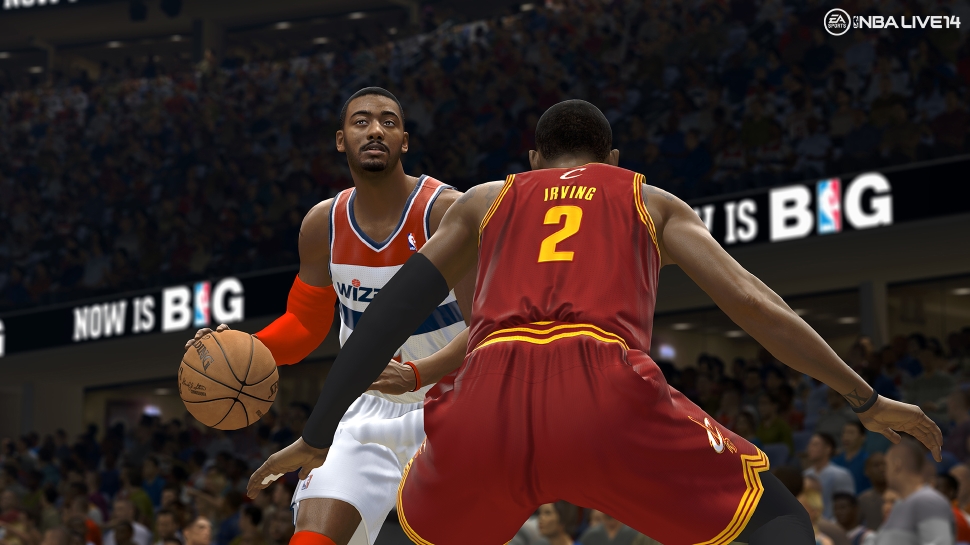
The jagged gameplay is joined by lacklustre visuals in making NBA Live 14 broadly unbecoming of what one expects in a next-generation sports. When players are working unmolested — bringing the ball up, working on a curl at the perimeter, backing into a man to call for a pass, you see some lifelike animations. In interactions though, NBA Live 14 has a long way to go, as it copes with recognising the positions of players on the floor and then applying the correct motion to their behaviour. You can see it most when you set up the no-rules practice environment and the players chug to comprehend the fact there’s no shot clock and no out of bounds.
They still do dumb things when normal rules apply. In one case, I left Derrick Williams of the Minnesota Timberwolves all alone (I had gone to help out on a pick, but nobody switched with me). There was no player within 12 feet in any direction. Rather than bury the open jumper he tried to feed the ball to Kevin Love in the low post. The defender knocked the ball loose, back to Williams, who tried to feed it to Love a second time rather than take the shot, resulting in a turnover.
The bulk of the game’s visual appeal rests on its ESPN presentation, which is solidly built but, honestly, was built in Bristol, Conn., not by EA Sports. Mike Breen and Jeff Van Gundy supply a capable commentary, but Van Gundy’s scripted anecdotes will drive you crazy from repetition, especially when you’re restarting a Big Moments challenge with the Golden State Warriors and Van Gundy is snarking on Mark Jackson’s attire for a sixth straight time. The rest of what they say is often generic and noticeably unobservant of context.
NBA Live 14 is a game of misplaced priorities, the first borne of the idea that NBA Live 10 was a poor game just because it sold poorly. Distinctive gameplay deserves a tutorial and a practice arena where players can get a feel for what’s expected of them before launching into the deep end of a discouraging debut in Rising Star or Dynasty. Otherwise, your earliest exposures to the game feel arbitrary and unfair.
Instead, you can see where the game spent time putting resources into subtle things like how the controller tries to rumble to tip you off to which side your man will go in post-up play. That’s to say nothing of the bouncing ball physics, an upgrade I can barely observe and isn’t on the list of weaknesses in NBA 2K. NBA Live 14 built a career mode, sure, but it’s one where the offence doesn’t run until you tell it to. All of these things pose a deadly barrier to fun. You really have to want to play this game, in the face of the discouragement it serves.
Had NBA Live 14 supplied understandable gameplay, leaning on the solid, recognisable presentation of ESPN and the neatly designed team and player challenges offered by the ongoing season, we could have had a justifiable alternative to NBA 2K14 — not on a full service basis, but at least on some fundamental component. I do not think the MLB 2K series is a better game than MLB The Show, for example, but its pitching controls are certainly a lot more enjoyable. The fact that NBA 2K14 puts so much of its gameplay behind an online connection, where NBA Live 14 does not, also is a missed opportunity for the challenger.
NBA Live 14 is not a game built, or rebuilt, over a three- or four-year span. Gamers may assume that it is, given the long absence of an annual title, but EA Sports used that time to crumple up sketches and throw them at the wastebasket. There may be no reason to sink the time into understanding NBA Live 14 when a comprehensively better game, which will teach you how to play it, already exists and is better looking, to boot.
But at least when NBA Live goes back to the drawing board next year — if it goes back to the drawing board next year — it won’t be starting with a blank page.
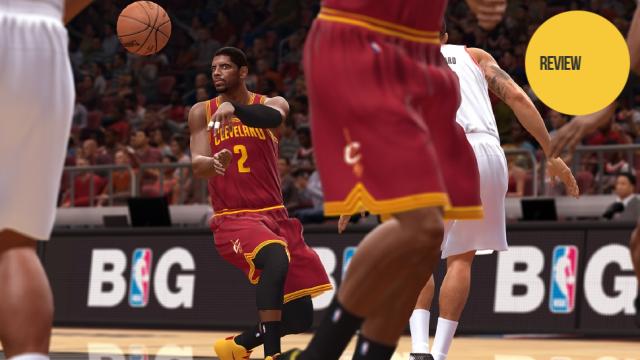
Comments
5 responses to “NBA Live 14: The Kotaku Review”
Personally NBA Live 14 should have been released on PS3.
Then again – the graphics are very sub-par for a next gen title, the commentary is very woeful and doesn’t use their ESPN licence well enough and the gameplay is not the greatest.
As Owen said, this is meant to be a reboot of the franchise but it needs time to develop. For me NBA Live needs to do a few things
– Better motion capping and greatly improve the representation of players (they still look ugh! compared to NBA 2K14)
– More immerse career mode (the Live Ulitmate Team stuff is good)
– Better integration with their ESPN Licence
– Bring back the All-Star Weekend and especially the Dunk Contest from NBA Live 08 (2K’s dunk contests from 2K13 and 2K14 are woeful – I don’t want to do guitar hero-esqe control sequence to dunk…NBA Live 08 had the dunk contest perfected
These really crack me up:
http://www.pageqsports.com/wp-content/uploads/2013/11/LeBron-James-NBA-Live-2k-14.jpg
http://pbs.twimg.com/media/BZijBd5CQAAnsob.jpg
Is that Eddy Curry in the first pic?
As an avid Timberwolves fan, I can tell you that seeing Derrick Williams do things like this is not all that unrealistic.
Beat me to it.
I will also say that all the complaints about how tricky it is to pick the proper shooting window, the lack of a good tutorial, the tricky and unintuitive ballhandling controls and the opaque playcalling controls… all apply to the last NBA2K I played, NBA 2K11 (if all that has now improved, I’m glad to hear it as I was considering picking up NBA2k14 when I get a PS4).